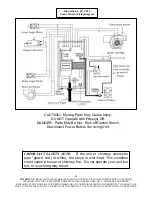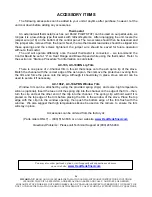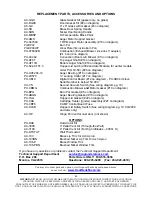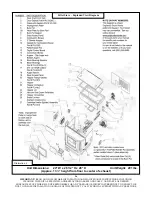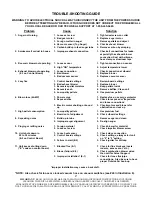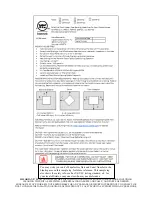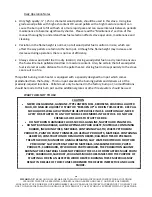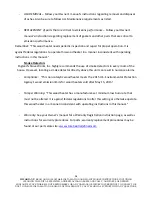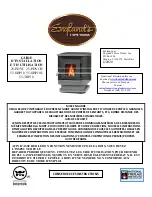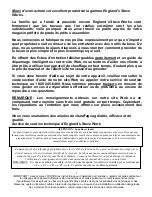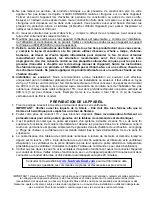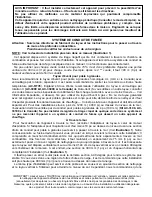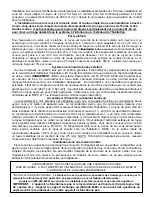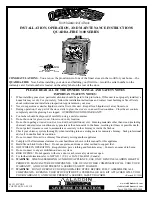
IMPORTANT!
READ AND FOLLOW
ALL
INSTALLATION AND MAINTENANCE INSTRUCTIONS, INCLUDING
CLEANING THE UNIT AS SPECIFIED, AND REPLACING GASKETS ANNUALLY, AND PARTS AS NEEDED.
ENGLAND’S STOVE WORKS IS NOT RESPONSIBLE FOR ANY DAMAGE OR INJURY INCURRED DUE TO NEGLECT, OR
DUE TO UNSAFE INSTALLATION OR USAGE OF THIS PRODUCT. CALL TECHNICAL SUPPORT WITH ANY QUESTIONS.
34
Additional
Venting
Information
Do
not
mix
and
match
components
from
different
pipe
manufacturers
when
assembling
your
venting
system
(i.e.
Do
NOT
use
venting
pipe
from
one
manufacturer
and
a
thimble
from
another).
We
require
a
minimum
vertical
rise
of
36
in.
(3
ft.)
of
pipe
to
create
natural
draft
in
the
system,
which
helps
evacuate
smoke
from
the
stove
in
the
event
of
a
power
failure
or
combustion
blower
failure.
Venting
systems
15.0
ft.
or
shorter
may
be
composed
entirely
of
3.0
in.
pellet
pipe;
to
reduce
frictional
losses,
venting
systems
longer
than
15.0
ft.
should
be
composed
of
4.0
in.
pellet
pipe.
Do
not
terminate
the
venting
system
directly
beneath
any
combustible
structure
such
as
a
porch
or
deck.
Follow
NFPA
211
rules
listed
below
for
venting
system
termination
location
relative
to
windows
and
other
openings
in
the
dwelling.
o
NFPA
211
(2006
ed.)
Section
10.4
Termination:
10.4.5
(1)
The
exit
terminal
of
a
mechanical
draft
system
other
than
direct
vent
appliances
(sealed
combustion
system
appliances)
shall
be
located
in
accordance
with
the
following:
(a)
Not
less
than
3
ft.
(.91
m)
above
any
forced
air
inlet
located
within
10
ft.
(3.0m).
(b)
Not
less
than
4
ft.
(1.2
m)
below,
4
ft.
(1.2
m)
horizontally
from
or
1
ft.
(305
mm)
above
any
door,
window
or
gravity
air
inlet
into
any
building.
(c)
Not
less
than
2
ft.
(0.61
m)
from
an
adjacent
building
and
not
less
than
7
ft.
(2.1
m)
above
grade
when
located
adjacent
to
public
walkways.
Distance
between
the
termination
opening
and
grade
should
be
a
minimum
of
2
ft.
(24
in.)
contingent
on
the
grade
surface
below
the
termination.
When
determining
the
termination
height
above
grade,
consider
snow
drift
lines
and
combustibles
such
as
grass
or
leaf
accumulation.
In
areas
where
significant
snowfall
is
possible,
the
termination
height
must
be
sufficiently
high
to
keep
the
termination
free
of
snow
accumulation.
Do
not
use
makeshift
compromises
during
installation
or
install
any
component
of
the
unit
or
venting
system
in
such
a
manner
that
could
result
in
a
hazardous
installation.
A
chimney
connector
shall
not
pass
through
an
attic
or
roof
space,
closet
or
similar
concealed
space,
or
a
floor,
or
ceiling.
Where
passage
through
a
wall
or
partition
of
combustible
material
is
desired,
the
installation
shall
conform
to
CAN/CSA
‐
B365.
WARNING:
Venting
system
surfaces
get
HOT,
and
can
cause
burns
if
touched.
Noncombustible
shielding
or
guards
may
be
required.
Summary of Contents for 25-PDVC
Page 39: ......



